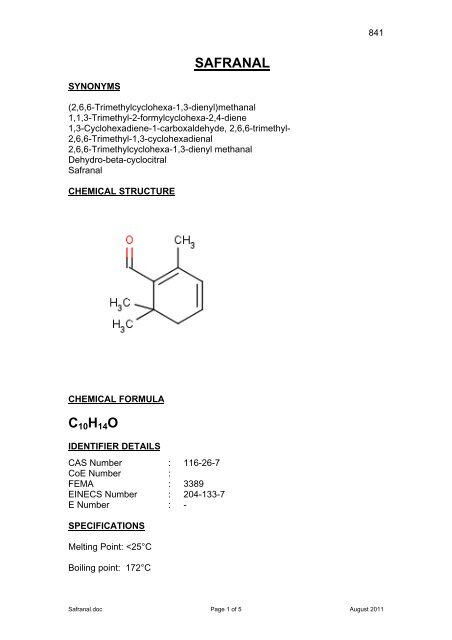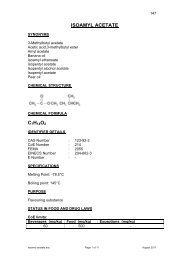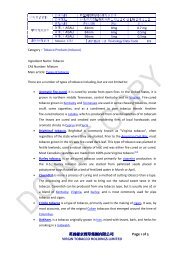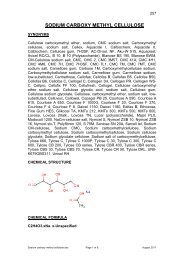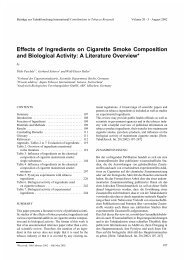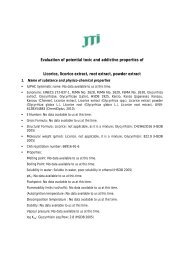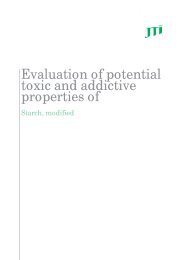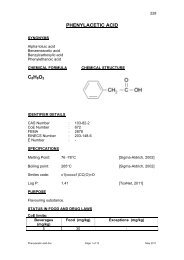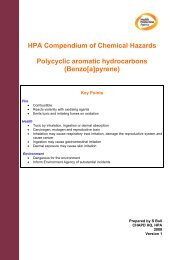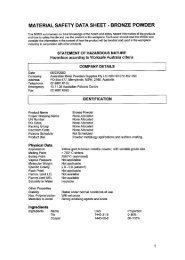Create successful ePaper yourself
Turn your PDF publications into a flip-book with our unique Google optimized e-Paper software.
SYNONYMS<br />
<strong>SAFRANAL</strong><br />
(2,6,6-Trimethylcyclohexa-1,3-dienyl)methanal<br />
1,1,3-Trimethyl-2-formylcyclohexa-2,4-diene<br />
1,3-Cyclohexadiene-1-carboxaldehyde, 2,6,6-trimethyl-<br />
2,6,6-Trimethyl-1,3-cyclohexadienal<br />
2,6,6-Trimethylcyclohexa-1,3-dienyl methanal<br />
Dehydro-beta-cyclocitral<br />
Safranal<br />
CHEMICAL STRUCTURE<br />
CHEMICAL FORMULA<br />
C10H14O<br />
IDENTIFIER DETAILS<br />
CAS Number : 116-26-7<br />
CoE Number :<br />
FEMA : 3389<br />
EINECS Number : 204-133-7<br />
E Number : -<br />
SPECIFICATIONS<br />
Melting Point:
PURPOSE<br />
Flavouring substance.<br />
STATUS IN FOOD AND DRUG LAWS<br />
CoE limits: (Provisional)<br />
Beverages (ppm) Food (ppm) Exceptions (ppm)<br />
- - -<br />
Acceptable Daily Intake:<br />
ADI (mg/kg) ADI Set by Date Set Comments<br />
- - - -<br />
FDA Status:[CFR21]<br />
Section Number Comments<br />
- -<br />
HUMAN EXPOSURE<br />
Natural Occurrence: Safranal is reportedly found as a glucoside in saffron.<br />
Also reportedly found in grapefruit juice, saffron, black tea, green tea,<br />
bourbon, lemon, and sweet grass oil (Fenaroli, 2005)<br />
Reported Uses: Safranal is reportedly use in baked goods at 10ppm,<br />
condiments at 5 ppm, jams at 10 ppm and soft candy at 5 ppm (Fenaroli,<br />
2005)<br />
TOXICITY DATA<br />
In vivo Toxicity Status<br />
Carcinogenicity and Mutagenicity<br />
In a study conducted by Hariri et al., (2011), the effect of crocin and safranal<br />
was studied against subacute toxicity of diazinon (DZN) on hematological and<br />
genotoxicity indices in rats. The rats were divided into 16 groups consisted of<br />
6 rats in control, diazinon, vitamin E, vitamin E and DZN, crocin (3 doses),<br />
crocin (3 doses) and DZN, safranal (3 doses), safranal (3 doses) and DZN<br />
groups. Vitamin E (200 IU/kg), safranal at doses 0.025, 0.05 and 0.1 ml/kg<br />
and crocin at doses 50, 100 and 200 mg/kg were injected intraperitoneally to<br />
rats three times per week alone or with DZN (20 mg/kg/day, orally) for 4<br />
weeks. Hematological parameters were evaluated at the end of 4 weeks. The<br />
evaluation of genotoxicity was done using the micronucleus assay. Vitamin E<br />
and, at lower doses, safranal (0.025 and 0.05 ml/kg) and crocin (50 mg/kg)<br />
restored the reduction of red blood cell, hemoglobin and hematocrit indices<br />
induced by DZN. These agents at some doses also prevented the reduction in<br />
platelets counts indices in diazinon treated group. A significant increase in<br />
reticulocyte was induced by diazinon. Vitamin E, safranal (0.025 or 0.05<br />
Safranal.doc Page 2 of 5 August 2011
ml/kg) and all doses of crocin decreased this effect of diazinon. In all doses<br />
vitamin E, crocin and safranal did not inhibit the effect of diazinon on RBC<br />
cholinesterase activity. A significant increase in micronucleus indices was<br />
seen with diazinon. Vitamin E, safranal and crocin could not prevent this<br />
genotoxicity. This study showed that vitamin E, safranal and crocin (without<br />
effects on cholinesterase) reduced diazinon hematological toxicity, but they<br />
did not prevent the genotoxicity induced by diazinon.<br />
Dermal toxicity<br />
No data identified.<br />
Inhalation toxicity<br />
No data identified.<br />
Reproductive and developmental toxicity<br />
In a study conducted by Hosseinzadeh et al., (2008), the aphrodisiac activities<br />
of Crocus sativus stigma aqueous extract and its constituents, safranal and<br />
crocin, were evaluated in male rats. The aqueous extract (80, 160 and<br />
320mg/kg body wt.), crocin (100, 200 and 400mg/kg body wt.), safranal (0.1,<br />
0.2 and 0.4ml/kg), sildenafil (60mg/kg body wt., as a positive control) and<br />
saline were administered intraperitoneally to male rats. Mounting frequency<br />
(MF), intromission frequency (IF), erection frequency (EF), mount latency<br />
(ML), intromission latency (IL) and ejaculation latency (EL) were the factors<br />
evaluated during the sexual behavior study. Crocin, at all doses, and the<br />
extract, especially at doses 160 and 320mg/kg body wt., increased MF, IF and<br />
EF behaviors and reduced EL, IL and ML parameters. Safranal did not show<br />
aphrodisiac effects. The present study reveals an aphrodisiac activity of<br />
saffron aqueous extract and its constituent crocin.<br />
Other relevant studies<br />
No data identified.<br />
Behavioural data<br />
No data identified.<br />
In Vitro Toxicity Status<br />
Carcinogenicity and mutagenicity<br />
The mutagenicity of the smoke condensate was assayed in the Salmonella<br />
plate incorporation [Ames] assay with the tester strain TA98 in the presence of<br />
an S9 metabolic activation system. The cytotoxicity of the cigarette<br />
condensate was determined in the neutral red uptake assay and the (3-(4,5dimethylthiazol-2-yl)-5-(3-carboxymethoxyphenyl)-2-(4-sulfophenyl)-2H<br />
tetrazolium, inner salt assay (MTS assay) with the human hepatocellular liver<br />
Safranal.doc Page 3 of 5 August 2011
carcinoma cell line, HEP-G2. It was concluded that the in vitro mutagenicity<br />
and cytotoxicity of the cigarette smoke was not increased by the addition of<br />
the ingredients, which included Safranal at levels up to 15 ppm.<br />
Extracts of saffron (Crocus sativus L.) have been reported to inhibit cell<br />
growth of human tumor cells. In order to study the cytotoxic effect of the<br />
characteristic compounds of saffron spice, Escribano et al., (1996) isolated<br />
crocin, crocetin, picrocrocin and safranal. Doses inducing 50% cell growth<br />
inhibition (LD50) on HeLa cells were 2.3 mg/ml for an ethanolic extract of<br />
saffron dry stigmas, 3 mM for crocin, 0.8 mM for safranal and 3 mM for<br />
picrocrocin. Crocetin did not show cytotoxic effect. Cells treated with crocin<br />
exhibited wide cytoplasmic vacuole-like areas, reduced cytoplasm, cell<br />
shrinkage and pyknotic nuclei, suggesting apoptosis induction. Considering its<br />
water-solubility and high inhibitory growth effect, crocin is the more promising<br />
saffron compound to be assayed as a cancer therapeutic agent.<br />
The influence of safranal, a constituent of Crocus sativus L. stigmas, on<br />
methyl methanesulfonate (MMS)-induced DNA damage was examined using<br />
alkaline single-cell gel electrophoresis (SCGE), or comet, assay in multiple<br />
organs of mice (liver, lung, kidney, and spleen) by Hosseinzadeh et al.,<br />
(2007). NMRI mice were divided into five groups, each of which contained five<br />
mice. The animals in different groups were received the following chemicals:<br />
physiological saline (10 mL/kg, ip), safranal (363.75 mg/kg, ip), MMS (120<br />
mg/kg, ip), safranal (72.75 mg/kg, ip) 45 min prior to MMS administration, and<br />
safranal (363.75 mg/kg, ip) 45 min prior to MMS administration. Mice were<br />
sacrificed about 3 h after the administration of direct mutagen MMS, safranal,<br />
or saline, and the alkaline comet assay was used to evaluate the influence of<br />
safranal on DNA damage in different mouse organs. Increase in DNA<br />
migration was varied between 9.08 times (for spleen) and 22.12 times (for<br />
liver) in nuclei of different organs of MMS-treated mice, as compared with<br />
those of saline-treated animals (p < 0.001). In control groups, no significant<br />
difference was found in the DNA migration between safranal- and salinepretreated<br />
mice. The MMS-induced DNA migration in safranal-pretreated mice<br />
(363.75 mg/kg) was reduced between 4.54-fold (kidney) and 7.31-fold (liver)<br />
as compared with those of MMS-treated animals alone (p < 0.001). This<br />
suppression of DNA damage by safranal was found to be depended on the<br />
dose, and pretreatment with safranal (72.75 mg/kg) only reduced DNA<br />
damage by 25.29%, 21.58%, 31.32%, and 25.88% in liver, lung, kidney, and<br />
spleen, respectively (p < 0.001 as compared with saline-treated group). The<br />
results of the present study showed that safranal clearly repressed the<br />
genotoxic potency of MMS, as measured by the comet assay, in different<br />
mouse organs, but the mechanism of this protection needs to be more<br />
investigated using different in vitro system assays and different experimental<br />
designs.<br />
REFERENCES<br />
Escribano J, Alonso GL, Coca-Prados M, Fernandez JA. (1996). Crocin,<br />
safranal and picrocrocin from saffron (Crocus sativus L.) inhibit the growth of<br />
human cancer cells in vitro. Cancer Lett. 100(1-2):23-30. [Cancer letters]<br />
Safranal.doc Page 4 of 5 August 2011
Fenaroli (2005) Fenaroli's Handbook of Flavor Ingredients, 5th Edition, CRC<br />
Press, London.<br />
Hariri AT, Moallem SA, Mahmoudi M, Hosseinzadeh H. (2011). The effect of<br />
crocin and safranal, constituents of saffron, against subacute effect of<br />
diazinon on hematological and genotoxicity indices in rats. Phytomedicine.<br />
15;18(6):499-504.<br />
Hosseinzadeh H, Sadeghnia HR (2007). Effect of safranal, a constituent of<br />
Crocus sativus (saffron), on methyl methanesulfonate (MMS)-induced DNA<br />
damage in mouse organs: an alkaline single-cell gel electrophoresis (comet)<br />
assay. DNA Cell Biol. 26(12):841-6. [DNA and cell biology]<br />
Hosseinzadeh H, Ziaee T, Sadeghi A. (2008). The effect of saffron, Crocus<br />
sativus stigma, extract and its constituents, safranal and crocin on sexual<br />
behaviors in normal male rats. Phytomedicine. 2008, Jun; 15(6-7):491-5.<br />
Safranal.doc Page 5 of 5 August 2011


